Howard Andrew Jones's Blog, page 9
July 3, 2018
Editorial Choices
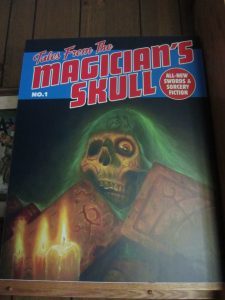 Back in May, my friend Keith asked for a few more details about what goes on behind the scenes at a magazine. Specifically, he wrote: “I’d love to read about what it’s like to edit a magazine, not just about submissions and what you look for in a story (although that is of much interest), but what all is involved in putting a publication together. In other words, I’m interested in the nuts and bolts of what goes on behind the scenes.”
Back in May, my friend Keith asked for a few more details about what goes on behind the scenes at a magazine. Specifically, he wrote: “I’d love to read about what it’s like to edit a magazine, not just about submissions and what you look for in a story (although that is of much interest), but what all is involved in putting a publication together. In other words, I’m interested in the nuts and bolts of what goes on behind the scenes.”
I can’t speak from a position of great authority, as I’ve only worked on two magazines, but I can speak with familiarity about Tales From the Magician’s Skull, the caveat being that each issue has been a little different. With the third issue underway, though, it feels as if routines are getting into place.
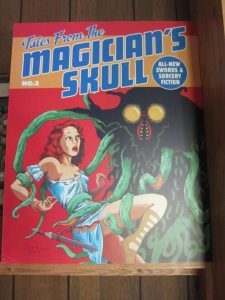 Issue 2 is currently at the printers, but I’ve already begun soliciting stories for issue 3. Top on the list are either authors I’ve been planning to contact (I’ve a long list of people I want to get into the magazine) or writers who have already had series characters appear in the magazine. Our intention is to get a variety of old and new into every issue.
Issue 2 is currently at the printers, but I’ve already begun soliciting stories for issue 3. Top on the list are either authors I’ve been planning to contact (I’ve a long list of people I want to get into the magazine) or writers who have already had series characters appear in the magazine. Our intention is to get a variety of old and new into every issue.
Once the stories come in, I read them. Sometimes I suggest some changes and a back and forth begins with the writer that may take multiple passes. Sometimes I like it well enough that I send it straight on to publisher Joseph Goodman for final consideration. Sometimes the story isn’t quite right for the magazine. Because I’m not opening to general submissions yet I’m getting professional work, so the choice whether to include or not really comes down to tone rather than proficiency.
If Joseph has changes or issues the story goes back to the writer, and sometimes there are back and forths and brainstorming sessions about titles.
Once a story is accepted Joseph starts lining up art, and that’s completely his bag, not only because of his connections after years of hiring illustrators for games, but because he’s actually studied art and, unlike me, has some artistic skill. When I’m about two-thirds of the way through picking content I write our advertisers to see if they’re interested in coming on board for another issue, and occasionally I get contacted by new advertisers. When the ads come in I send them on to Joseph and Lester, our layout genius.
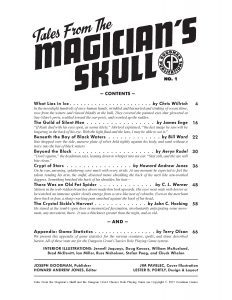 Lester doesn’t start real work on the issue until he gets all of the advertisements and stories in one big batch. Usually by then I’ll have determined an order to the stories, but sometimes I’ll keep playing with the order even through layout stage. I hope to avoid that in the future, but with issue 2 I couldn’t help myself. I like to lead and finish with strong action pieces, and I like to put the more divergent in tone deeper in the issue, interspersed with those more squarely under the sword-and-sorcery banner. I like to vary the feel of the pieces so that we don’t have the same kind of tone in each story, one after the other.
Lester doesn’t start real work on the issue until he gets all of the advertisements and stories in one big batch. Usually by then I’ll have determined an order to the stories, but sometimes I’ll keep playing with the order even through layout stage. I hope to avoid that in the future, but with issue 2 I couldn’t help myself. I like to lead and finish with strong action pieces, and I like to put the more divergent in tone deeper in the issue, interspersed with those more squarely under the sword-and-sorcery banner. I like to vary the feel of the pieces so that we don’t have the same kind of tone in each story, one after the other.
After issue 1 we started getting letters, and I expect the same thing will happen when issue 2 gets released as a full-fledged print magazine. As the letters trickle in Joseph sends them along and I channel the skull in answering them. That’s honestly a whole lot of fun. Some of the last pieces we put together are the editorial, and a word from the Skull. We also vary the titles on the pile of books that the Skull is sitting on in the illustration associated with the Skull’s observations.
After Lester makes his first pass I read it, Joseph reads it, a copyeditor reads it, and all of the authors get sent a copy as well. Lester then addresses any changes and Joseph and I read through it a final time. After that Joseph takes over and runs it through the printing gauntlet. I’m not sure what happens there.
For the first two issues, Joseph selected the cover art ahead of time. We’ve just started discussing what piece ought to be featured on the cover of issue 3, so going forward I think Joseph may be planning to have the illustration tied to the material within the magazine.
Keith, is that everything you were curious about? Anything more you want to know, or something I’ve left out?
Addendum 1: I neglected a step with which I have minimal involvement. Once all the stories are in, Joseph passes them on to our Dungeon Crawl Classics guru, Terry Olson, who decides what objects or creatures deserve a write-up in DCC rules, so that they can be used in games inspired by the stories. He creates not just the rules, but the snappy text that describes the monster or treasure item.
Addendum 2: There are maps. Sometimes an issue will have more stories where a map can be used than others. Joseph and I both like maps, so once all the stories are in the two of us trade ideas about which ones could benefit from one, and then he contacts one of his illustrators, gives them the story and a few guidelines, and they get to work.
July 2, 2018
Guilds & Glaives Released
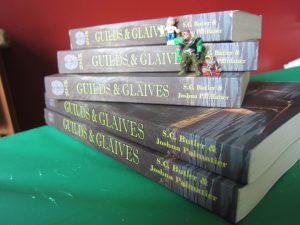 Right here in my own tower by the sea I have contributor’s copies of the mighty Guilds & Glaives anthology. Along with numerous talented folks, my sword-and-sorcery colleagues and fellow Tales From the Magician’s Skull authors Violette Malan (writing of Dhulyn and Parno) and James Enge (writing of Morlock) can be found within its pages.
Right here in my own tower by the sea I have contributor’s copies of the mighty Guilds & Glaives anthology. Along with numerous talented folks, my sword-and-sorcery colleagues and fellow Tales From the Magician’s Skull authors Violette Malan (writing of Dhulyn and Parno) and James Enge (writing of Morlock) can be found within its pages.
My story, “The Sword and the Djinn,” is an excerpt from the third, unpublished, Dabir and Asim novel. It doesn’t actually feature either character, but is one of several short stories composed for inclusion in the manuscript. The Maiden’s Eye, when finally complete, is going to feel even more closely tied to the Arabian Nights tradition than the previous works, because it will feature numerous stories within stories. At least, that’s my conception of it. My ambitions were one of the problems with the composition of that book, because how does one maintain pace when stopping to tell additional stories? Lately I think I may have figured it all out, but I’ve been too busy with other deadlines to sit down and do it.
The other item about this story that may interest some (well, a very small number of you who’ll recognize what I’m writing about) is that it makes direct reference to the Gray Maiden stories of Arthur D. Howden Smith. As a matter of fact, it might just BE a lost story from that cycle of tales! You can be the judge of that. I mean, I wrote it, but maybe the same muse came and spoke to me. I do know that within the pages of The Maiden’s Eye Asim ends up in possession of Gray Maiden.
The wife keeps getting on me to fix that novel up and do something with it. And I will, I promise. But for now, you can read this out take, along with a whole bunch of other goodies, in Guilds & Glaives. You can find your own copy right here. Remember that it’s always easy to order from online, but that it ALWAYS helps the authors out if you buy the book from a physical bookstore. That means that the bookstore will order more copies, and then it will be seen by more people. So if you want this and will be driving past a B&N in the next week, it’s better to snag it that way.
June 26, 2018
Shelf Treasure
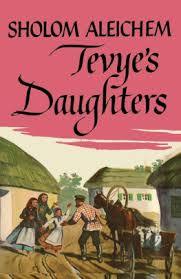 If you’re a bibliophile like me you may have similar books. You cart them around as you move and they stay on your shelf, and maybe you plan to read them, but you haven’t yet. Maybe, like me, you’re not even sure where some of them came from.
If you’re a bibliophile like me you may have similar books. You cart them around as you move and they stay on your shelf, and maybe you plan to read them, but you haven’t yet. Maybe, like me, you’re not even sure where some of them came from.
In the case of Tevye’s Daughters, I THINK it might have joined the bookshelf when my wife’s book collection merged with my own, but she’s never read it, either. We like Fiddler on the Roof quite a lot, and the collection Tevye’s Daughters is the anthology from which the musical was drawn… and it’s also a slim book. And yet I haven’t read it. In part that’s because I’m usually suspicious of books alleged to be funny, because I’ve so often been disappointed. And then I’ve been reading fantasy, or science fiction, or swashbucklers, or private eye books, or westerns, or history books… but not literature, apart from Shakespeare plays, because I usually bounce off of it.
For thirty years, Tevye’s Daughters has remained, patiently waiting as the contents around it have grown and changed, been partly depleted and then replaced. Since that book has been in our collection my shelves have completely transformed until one entire case is given over to two categories I never owned before the last 8 years (and most of those changes have come in the last 2). Me, reading detective novels and westerns?
My kids are big fans of Fiddler on the Roof, and my son in particular loves Tevye. The other day I happened to look over and spot Tevye’s Daughters book spine on the shelf. I brought it out and mentioned it to my son. I’ve done this thing in the past with various books for both kids, and it has almost never worked. This time, though, presenting a shelf treasure excited interest, and my first born blazed through it, loving every minute of it, following me around and reading quotes from Tevye.
Looks like I’ll be following up his read with one of my own. It only took three decades. I wonder what other treasures are there?
Incidentally, the pictured cover isn’t the one from my own edition. I couldn’t find an image of it, and it’s been wonky taking pics lately, so I just used this one.
Anyone else out there have any interesting shelf treasures they unearthed after letting them sit for years?
June 25, 2018
Happiness
 It’s been a busy but happy weekend here at the Jones household. I didn’t have enough time to put a long essay together, so I thought I’d share some happiness instead.
It’s been a busy but happy weekend here at the Jones household. I didn’t have enough time to put a long essay together, so I thought I’d share some happiness instead.
First, my daughter came home from the camp where she’s a counselor all summer, went to college orientation with her mother, and then celebrated her (somewhat belated) 18th birthday with us. There were presents and ice cream cake and a weird spinning mechanical candle that blared “Happy Birthday” and refused to die. We went out to celebrate at a really nifty Chinese restaurant, a first for our city, so far as I know, for it serves dim sum as well as some other goodies.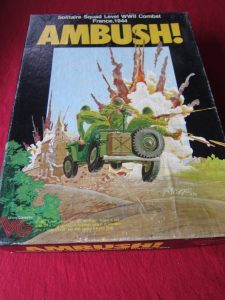
Alas, she had to leave Saturday night. Sunday I woke up early and finished mission 5 of Ambush! (there are 8 missions in the initial box) and got all of my servicemen out of the mission alive with some careful planning and a whole lot of luck. Then we proceeded to make a complicated meal, and were joined in its preparation by our old friend Bruce, who drove down and helped us make two kinds of home-made shell stuffing, one that was primarily sweet potato and one that was primarily spinach, garlic, and ricotta. I probably haven’t mentioned much that my wife is a fantastic cook, but she is, and the meal, complete with its home made pesto topping and home-made bruschetta, was fantastic. Heck, everything was home made but the shells, and she could have done that if she wanted.
We also took in a nice walk with the dogs, then I ran a short Sherlock Holmes mystery adventure for Bruce, my wife, and my son. By then it was late and Bruce headed home. While my family watched a David Attenborough nature show I curled up in a nearby chair and finished a tasty western by Ray Hogan.
It was a good weekend.
June 22, 2018
Robots of Gotham: Sly, Slam Bang Action Adventure
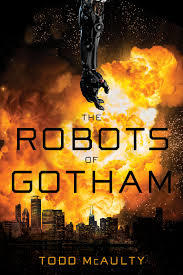 A few years ago I became a beta reader on a really swell manuscript that’s just now been released in hardcover. It’s already garnering some strong reviews, and I’m not surprised. It was strong in rough draft and it was even stronger as I read additional changes. Robots of Gotham is just a great read, and I was honored to blurb it.
A few years ago I became a beta reader on a really swell manuscript that’s just now been released in hardcover. It’s already garnering some strong reviews, and I’m not surprised. It was strong in rough draft and it was even stronger as I read additional changes. Robots of Gotham is just a great read, and I was honored to blurb it.
Yeah, it’s not sword-and-sorcery, and it’s not historical fiction, but remember that I DO love me some space opera… but it’s not that, either. It’s science fiction in the near future, which doesn’t at all sound like my cup of tea. EXCEPT that it’s full of adventure, and suspense, and great action bits, and a hero who rises to the occasion, and dangerous and capable and well-motivated villains, and mystery. I mean, I could hardly stop reading it even in its rough state, and I never dreamed it was as looong as the thing is because it absorbed me so deeply. The thing’s huge, and not really my genre — and I COULDN’T PUT IT DOWN. I think that says a lot. It was so engaging I blew off my own writing time and just kept reading. Only a handful of modern writers can pull that off.
The book’s by the somewhat unknown Todd McAulty, best remembered for some great work in the early days of Black Gate magazine. He hasn’t published much, if anything, since. I hope to lure him over to the site for an interview some time soon.
Anyway, two thumbs way, way up for me. Anyone who digs clever heroes and well motivated characters and lots of great suspense should sign on. Especially if you like robots. You can find it here, or better, at your local store, because it still does more good for the writer if you pick it up from a physical bookstore. The store will stock more copies if you buy from them, and the more copies ordered from the store, the longer it stays on the shelf, and the better chance it sells more copies. It’s not a perfect system…
June 21, 2018
Pictures in the Fire
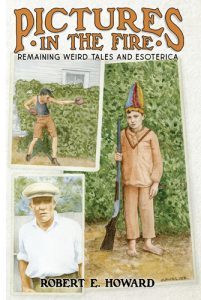 I just saw that the Robert E. Howard Foundation is about ready to release a new book that collects some uncollected (at least in nice hardback editions) weird fiction and some other goodies by the man himself. It looks as though none of it is juvenalia, which is good, because while I realize stuff written when REH was a kid is great for scholars, I’m not interested in reading it myself.
I just saw that the Robert E. Howard Foundation is about ready to release a new book that collects some uncollected (at least in nice hardback editions) weird fiction and some other goodies by the man himself. It looks as though none of it is juvenalia, which is good, because while I realize stuff written when REH was a kid is great for scholars, I’m not interested in reading it myself.
There are also a substantial number of fragments. When it comes to Robert E. Howard, sometimes these fragments contain nifty little scenes or gem like moments. I recall one historical fragment that had an unbelievably cool fight in a corridor, so I’ll probably end up reading them all, just as I listen to rarity tracks by favorite bands.
I’m putting it on my birthday list. Seeing as how I’m downsizing my consumption of NEW stuff, this book will probably be about the extent of my birthday list this year, although, as I’m going to be hitting the half century mark, maybe I’ll treat myself to another of those wargames I enjoy so much…
Anyway, go to the page and check it out.
June 20, 2018
Father’s Day
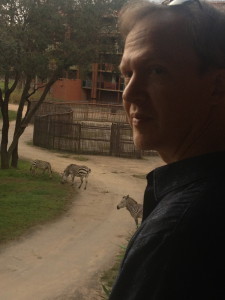 My father never held much stock with Father’s Day, thinking it an artificial construct designed to sell more cards, but I’ve embraced it. And this last Sunday I had one of my nicest Father’s Days ever. Heck, it began the night before, when I took the evening walk with my wife and son and they gave me some fantastic ideas for the villain and a terrible weapon for my third Dabir and Asim novel.
My father never held much stock with Father’s Day, thinking it an artificial construct designed to sell more cards, but I’ve embraced it. And this last Sunday I had one of my nicest Father’s Days ever. Heck, it began the night before, when I took the evening walk with my wife and son and they gave me some fantastic ideas for the villain and a terrible weapon for my third Dabir and Asim novel.
The next day I was treated, if not quite king-like, as someone who didn’t have to do any chores, be they mucking the stalls or doing the dishes. In the morning I got up early, as usual, and worked away on the outline of a new short story. Then I was taken out for lunck, treated to a role-playing game run by my son, and given a new Lock ‘n Load Tactical game. Well, new to me. Between lunch and the start of the game I got in a little Ambush!, another of my favorite war games.
The only jarring event was when we were out to lunch with my father-in-law and he told my son the reason universities are so expensive now: it’s because all the Mexican immigrants are getting free educations. Our jaws dropped, and my wife managed to change the topic of conversation before we had an ungentlemanly discussion. That reminded me not only of how many people are walking beside me living in alternate realities, but of all those fathers unjustly separated from their children. I’ve been stewing about that last a lot, so much so that even though I had time to blog Tuesday I wasn’t sure what to say. I try to keep my blog free of politics.
But there’s a difference between a political issue and a moral issue. I believe men should practice gentlemanly conduct. Separating children from their parents like this isn’t just immoral and ungentlemanly, it’s evil, and I want my congressional representative to show some actual spine and call the president on it. This travesty can be changed with a signature.
June 18, 2018
Novel Lessons 4: Stalking the Beast
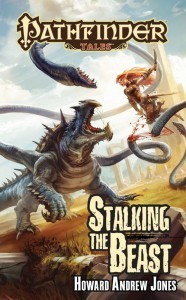 After delivering a draft of The Bones of the Old Ones and while waiting upon editorial comments I wrote my second Pathfinder novel, Stalking the Beast. And while it proved much simpler in composition than writing Bones, it presented its own issues.
After delivering a draft of The Bones of the Old Ones and while waiting upon editorial comments I wrote my second Pathfinder novel, Stalking the Beast. And while it proved much simpler in composition than writing Bones, it presented its own issues.
By the time I sat down to write it I was beginning to understand that every novel has its own challenges. Stalking the Beast was a sequel novel to The Plague of Shadows, which was in some ways a search for identity by its protagonist, Elyana. By the end, Elyana was comfortable with herself and her past. I wasn’t entirely sure how to create a new struggle for someone who had found a way to get her sh*t together, so I decided to focus my efforts on her loyal half-orc friend, Drelm. Except that he was such a simple character I knew he couldn’t carry the narrative on his own.
Inspiration hit when I developed the third viewpoint character, Lisette, a gunslinger hired to kill Drelm. Her chapters were the easiest to write in the entire book, despite me knowing her the least. It was the oddest thing. Previous experience had shown me that knowing a character well was a great way into their head, but I learned that being INTERESTED in the character was real fuel as well. Lisette’s complicated life and motivations were so much more fun to write that they were vastly more simple to explore, so much so that I barely had to revise any of the chapters from her point of view at all.
It’s not that I didn’t LIKE Elyana or Drelm, it’s just that they weren’t as interesting to me now as Lisette. I enjoyed writing about her so much that I pitched the idea of writing some Lisette novels to James Sutter at GenCon after Stalking the Beast had come out, and he greenlit the idea in concept. Unfortunately I got so busy it never happened.
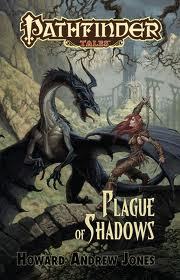 I had experimented with structure in my first Pathfinder novel; in this one I experimented as well, building it around the three viewpoints. I kept the order throughout the narrative: one chapter from Elyana, one from Drelm, one from Lisette, then back to Elyana. It was a little tricky to build it and time events so that everyone would have something to do when their narrative came round, and even more challenging so at THAT particular moment their particular narrative would be the best angle to experience the story by. Of all the things I did in the book, I guess I’m proudest of that.
I had experimented with structure in my first Pathfinder novel; in this one I experimented as well, building it around the three viewpoints. I kept the order throughout the narrative: one chapter from Elyana, one from Drelm, one from Lisette, then back to Elyana. It was a little tricky to build it and time events so that everyone would have something to do when their narrative came round, and even more challenging so at THAT particular moment their particular narrative would be the best angle to experience the story by. Of all the things I did in the book, I guess I’m proudest of that.
When I discussed Plague of Shadows I mentioned that I had no great love for the use of healing magics, and that I prefer lower magic settings both when I game and when I write. You know, a feel that’s more sword-and-sorcery. When playing Pathfinder, a GM can set the grit level as high or as low as he or she and the players want. But it turns out the default preferred by many of the novel readers is more “high” fantasy, where magic is ubiquitous and easy to come by, and by the time I was drafting Stalking the Beast I was aware that a number of readers were questioning why I didn’t have magical healing in the first book. Magical healing is one of my least favorite game novel features, because with that and resurrection, no death really has much weight or impact. It’s hard to get that gritty sword-and-sorcery feeling with such powerful drama wreckers hanging out as possibilities.
So I threw in a powerful healer to the group — then had him killed pretty soon after the adventure started. Hah! That allowed me to go ahead and tell the grittier story I wanted and give lip service to the high magic feel. It was cheating, though, and I knew that I wouldn’t be able to do that again.
As I look back on it, I think the novel mostly works. I believe I took some potentially cliche archetypes and twisted and deepened them and even provided a surprise or two. I’m not sure I spent enough time explaining what the villain was really about. It wouldn’t have taken much more time, but it needed a few more lines. That problem came in part from the same issue I was wrestling with in The Bones of The Old Ones, when I hadn’t really known the villains well enough when I began to write. In THIS instance, the more personal villain to the characters — the one wanting to kill Drelm — is pretty well explored, but the one providing the larger threat didn’t get quite enough screen time.
Next week I’ll either look at some of the hard lessons I learned while working on the still-unfinished third Dabir and Asim novel, or move on to my third Pathfinder novel.
June 15, 2018
Writer Chat: Chris Willrich
 During those long years when I was trying, and mostly failing, to get short stories published, there were a lot of writers publishing at the same time whose work I liked, but there was only one who I wanted to sound like. That writer was Chris Willrich. I’ve gone on to find my own voice for my fiction, one I’m pretty happy with, but I still admire the work of Chris Willrich an awful lot.
During those long years when I was trying, and mostly failing, to get short stories published, there were a lot of writers publishing at the same time whose work I liked, but there was only one who I wanted to sound like. That writer was Chris Willrich. I’ve gone on to find my own voice for my fiction, one I’m pretty happy with, but I still admire the work of Chris Willrich an awful lot.
It was my pleasure to pick his brain a little recently, and today I’m sharing the resulting conversation.
First, why don’t you give us a little background about yourself and your work.
I’m from Washington State originally, though now I live with my family in the San Francisco Bay Area. Though I flirted a bit with science in college, I’ve been pretty much a book person — I was an English major who eventually ended up as a children’s librarian. There there were some interesting odd jobs in between, like working at a newspaper and as a harbor cruise deckhand. I’m writing full time now, for stay-at-home-parent values of “full time.”
I tried writing a little bit of realistic fiction in college but it’s been all fantasy and science fiction since then. I’ve had more success with fantasy, though I love science fiction equally. Those genres are like catnip for a compulsive daydreamer. I think I have an easier time finding a confident voice in fantasy; I haven’t quite figured it out for science fiction.
Because Gardner Dozois recently passed away, I’d like to say I’ll always be grateful to him for buying my first published story, and maybe even more for giving me encouragement and suggestions in some of the rejections I got from him. I think there are lots of people in the field who got their starts because of him, and who benefited from his advice.
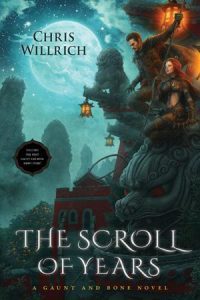 If you were going to direct readers to your fiction, what would you most like them to see?
If you were going to direct readers to your fiction, what would you most like them to see?
“The Sword of Loving Kindness” is free online at Beneath Ceaseless Skies magazine and in some ways it’s pretty representative — it features my recurring characters Gaunt and Bone, and has action, weird magic, philosophical asides, warped humor, and exotic locales. These are a few of my favorite things. If you bounce off that one, there’s a good chance you won’t like my stuff in general, and no worries about that. But if you do like it, maybe try the Gaunt and Bone story “The Mermaid and the Mortal Thing” online at Lightspeed magazine (also free), and maybe consider picking up the first Gaunt and Bone novel, The Scroll of Years (Pyr), which also includes their first story, “The Thief with Two Deaths” (from The Magazine of Fantasy and Science Fiction, June 2000.) And thanks!
Do you have some favorite writers? I’d love for you to discuss what you love about them, and what might be learned from studying their craft.
I’m always going back to Roger Zelazny. I think he combined depth with imagination and a spirit of fun. Beyond that, he was always trying new things with prose. I think the key thing I try to learn from Zelazny is the idea of the narrator as a performer who tries to keep a reader’s interest line by line, maybe even more so than scene by scene. This is especially evident with his first-person-snarky narrators like Corwin of Amber, but you see it all over his work. I read somewhere that he had a goal of a number of sentences per day rather than a number of words per day or a number of hours per day, which may suggest how he focused his attention, and how he managed such sparkling delivery.
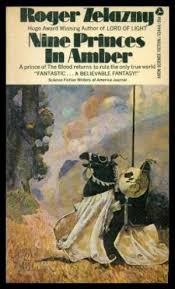 I sometimes think if I ever grow up as a writer I want to be like Ursula K. Le Guin, someone else we’ve recently lost, unfortunately. As with Zelazny there’s playfulness in Le Guin, but there’s also earthy truthfulness about life and how people deal with their good and bad choices. There’s a sense of a very thoughtful mind puzzling out important themes, judiciously. And Le Guin is a master, not just of “show don’t tell,” but of knowing what to show and when, and what to tell and when, and how much of both. Vivid scenes are woven into beautifully phrased narration, “show” becoming “tell” and back again. There is an essay on Le Guin’s web site about showing and telling and other things, here: http://www.ursulakleguin.com/AboutWriting13-OnRulesofWriting.html
I sometimes think if I ever grow up as a writer I want to be like Ursula K. Le Guin, someone else we’ve recently lost, unfortunately. As with Zelazny there’s playfulness in Le Guin, but there’s also earthy truthfulness about life and how people deal with their good and bad choices. There’s a sense of a very thoughtful mind puzzling out important themes, judiciously. And Le Guin is a master, not just of “show don’t tell,” but of knowing what to show and when, and what to tell and when, and how much of both. Vivid scenes are woven into beautifully phrased narration, “show” becoming “tell” and back again. There is an essay on Le Guin’s web site about showing and telling and other things, here: http://www.ursulakleguin.com/AboutWriting13-OnRulesofWriting.html
I’ve recently become a big Terry Pratchett fan — I’ve been going through the Discworld books as read-alouds for my daughter — but I’m afraid I have no brilliant insights as to how he so often managed to be funny and deep at the same time. I do sense he had a largeness of spirit; there was a place in his heart for anyone who wasn’t, say, murdering people or cheating people out of their life savings, and even then he could usually spare a little empathy for the bad guys too. I think the other side of the coin from that largeness of spirit is that the man hated, and I mean hated, injustice, to the degree that I wonder if he cracked jokes about it to keep himself from spontaneously combusting. I think those qualities combine to make Discworld seem real, despite the narration repeatedly reminding you the world’s ultimately being supported by an enormous space turtle.
What writing projects are you working on right now?
I’m working on an epic fantasy with touches of steampunk, the working title of which is Anya Zephyr and the Glass Library.
How many Gaunt and Bone stories have there been? Have you put any thoughts into publishing a collection?
I think about trying to set up a collection sometimes. The main thing holding me back is that I’ve got pretty strong ideas for at least three stories to go along with the initial seven, below, and I’d rather have them all in place before doing a collection. Ideally I’d figure out a good thematic through-line for them, building on what’s gone before, so the compilation could feel somewhat cohesive. I remember reading Michael Moorcock’s Elric stories in book form, and how the books collecting the short works hung together side-by-side with the novels. Same with Fritz Leiber’s Fafhrd and the Gray Mouser, actually, although I haven’t finished reading all of those yet. I’d love to manage the same for Gaunt and Bone, eventually.
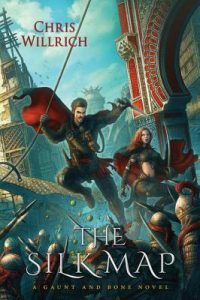 The publication dates of all the Gaunt and Bone tales are listed, but I’ve arranged them in an in-series order in case that’s of interest.
The publication dates of all the Gaunt and Bone tales are listed, but I’ve arranged them in an in-series order in case that’s of interest.
“The Thief with Two Deaths,” The Magazine of Fantasy & Science Fiction, June 2000. Reprinted in Bound for Evil: Curious Tales of Books Gone Bad, (Dead Letter Press 2008.) and The Scroll of Years (Pyr, 2013.)
“The Mermaid and the Mortal Thing,” Flashing Swords Summer Special 2008 Reprinted in Lightspeed Magazine, February 2012. [Free online.]
“The Sword of Loving Kindness, Parts 1 and 2,” Beneath Ceaseless Skies 1 and 2, October 2008. [Free online.]
“King Rainjoy’s Tears,” The Magazine of Fantasy & Science Fiction, July 2002. Reprinted in Fantasy: The Best of 2002 (ibooks, 2003), In Lands That Never Were (Four Walls Eight Windows, 2004) and The Mammoth Book of Warriors and Wizardry (Running Press, 2014.)
“Penultima Thule,” The Magazine of Fantasy & Science Fiction, August 2006.
“What Lies in Ice,” Tales from the Magician’s Skull 1, 2018.
“A Wizard of the Old School,” The Magazine of Fantasy & Science Fiction, August 2007.
The Scroll of Years (Pyr 2013)
The Silk Map (Pyr 2014)
The Chart of Tomorrows (Pyr 2015)
Also, the following stories take place in Gaunt and Bone’s world but are otherwise not related.
“The Lions of Karthagar,” Black Gate15, Spring 2011.
“How the Wicker Knight Would Not Move,” Beneath Ceaseless Skies 99, July 2012.
“Shadowdrop,” Beneath Ceaseless Skies, forthcoming.
Dream writing project – if you could get paid to write anything, what would you most like to draft?
Right now I’m pretty jazzed about Anya Zephyr, above, but I also hope to get all my many Gaunt and Bone ideas written down, and in particular I’d like to send them to a whole bunch more places, including settings inspired by Africa and the Pacific islands, and to take the time to research in depth to make those places feel “right.” I also want them to make some weird stops that are purely from my imagination. I don’t know how far I’ll get but that’s on the wish list. I’d also like to do more space opera stories — I love that genre. And I’d like to tackle hard science fiction, which I admire.
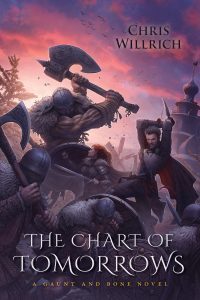 What do you most like to do when you’re not hunched over your computer screen crafting stories?
What do you most like to do when you’re not hunched over your computer screen crafting stories?
Dear Lord, I am boring. I like to take walks, hang out with the family, and on too-rare occasions run roleplaying games, which I love but don’t have much time for. (This does let me plug that I had the pleasure of doing a roleplaying tie-in book a while back, the Pathfinder Tales novel The Dagger of Trust.)
What are your favorite pieces of advice for other writers? Maybe advice you’d have wanted to hear a few years ago.
Although I love nuts and bolts tips on technique, the most useful advice for me personally has been more “meta.” So here are a few things …
When I was feeling morose about not selling enough of my writing, my wife advised me to just write what I enjoyed, and to stop sweating so much about what I thought editors wanted to buy. That’s when I got going on sword and sorcery, and more adventure-oriented material in general. And paradoxically, or so it seemed, I started selling my work more often than not. But I don’t think it’s really a paradox. If you’re not having much fun with your writing, chances are good your readers won’t be having fun either.
Joanna Russ told a writing class I was fortunate enough to be in something like the following: Writers sometimes fear they haven’t had enough suffering in their lives to have anything worth writing about. Don’t think like that. Life will inevitably serve up more trauma than you’re going to want, like it or not. She also told me, in so many words, not to take myself quite so very seriously. That’s probably the best advice I ever got from a pro.
Science fiction writer Tobias Buckell wrote something online that really resonated for me. I’ve tried to find the original blog post but this librarian must confess failure, alas. The gist of it was: Focus on what’s in your control. Whether or not you sell something is not under your control. How much your work takes off is not under your control. The publishing environment is not under your control. What is under your control? Your work habits, your craft, your enthusiasm. Put most of your energy where it counts, on what’s in your own sphere.
Thanks, Chris!
June 13, 2018
Gravity Falls
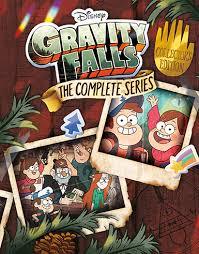 I’m locked away in the highest tower of my domain, working feverishly on a new draft, but I wanted to share with you that the complete Gravity Falls is now available for pre-order.
I’m locked away in the highest tower of my domain, working feverishly on a new draft, but I wanted to share with you that the complete Gravity Falls is now available for pre-order.
Gravity Falls is a wondrous, goofy, and extremely well-written show, stuffed full of creepy humor, thrills, lots of heart and good old fashioned heroics. Each episode is strong and most stand on their own, but they build into a wonderful interconnected, multi-layered story. It’s far more than it seems on first glance.
For years Disney refused to release it in its entirety, as they have done with many other TV properties, marketing only a few episodes here and there. But the fans were loud and the fans demanded and it seems that maybe Disney listened.
In any case, I just placed an order, in part for me, but also because my wife takes endless enjoyment in the show. There are always new minor details to notice in the background, because it was really well thought out from the start…
Howard Andrew Jones's Blog
- Howard Andrew Jones's profile
- 368 followers



